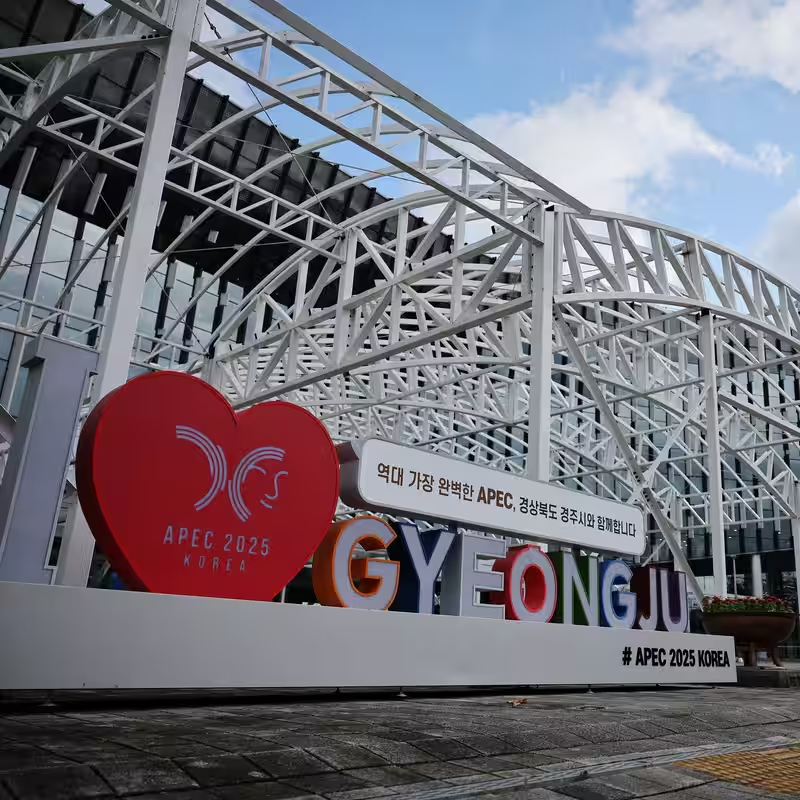Gyeongju, South Korea—a city famed for its ancient tombs, serene Buddhist temples, and UNESCO-listed pagodas—is racing against time to transform itself into a global diplomatic hub. With just days to go before the 2025 Asia-Pacific Economic Cooperation (APEC) summit, local and national authorities are in overdrive to accommodate a high-stakes gathering of world leaders, including former U.S. President Donald Trump and Chinese President Xi Jinping.
APEC in the Ancient Capital: A Logistical Tightrope
Unlike Seoul or Busan, Gyeongju wasn’t built for motorcades, secure perimeters, and five-star delegations. The city of just 260,000 people is more accustomed to hosting history buffs and school field trips than heads of state. Yet South Korea’s government deliberately chose this historic locale to showcase its cultural heritage while signaling a commitment to balanced regional development.
Now, the reality has hit hard. Officials have been scrambling to upgrade infrastructure, expand hotel capacity, and coordinate unprecedented security protocols—all while preserving the integrity of Gyeongju’s delicate archaeological sites.
What’s at Stake in Gyeongju?
The 2025 APEC summit arrives at a pivotal moment. With U.S.-China tensions simmering, global supply chains in flux, and climate commitments under scrutiny, the forum offers a rare neutral ground for dialogue. Trump, campaigning for a potential 2026 presidential run, is expected to use the platform to reassert American influence in the Indo-Pacific. Meanwhile, Xi’s attendance could signal Beijing’s willingness to re-engage on trade and tech regulations.
Other expected attendees include Japanese Prime Minister Fumio Kishida, Australian PM Anthony Albanese, and leaders from Canada, Mexico, Chile, and ASEAN nations—making this one of the most diplomatically charged APEC meetings in years.
Gyeongju’s Rapid Transformation: By the Numbers
| Category | Pre-APEC (2024) | Current (Oct 2025) |
|---|---|---|
| Available 5-star hotel rooms | 12 | 210 (via temporary luxury lodges & Seoul shuttles) |
| Security personnel deployed | Local police only | Over 8,000 (including national guard & cyber units) |
| Roads upgraded | Minimal | 42 km of new/repaved roads near summit venue |
| UNESCO site protections | Standard | Enhanced buffer zones & drone surveillance |
Local Reactions: Pride and Pressure
Many residents express pride at putting Gyeongju on the world stage. “This is our chance to show that Korea’s soul lives here, not just in skyscrapers,” said local shop owner Min-jae Park. But others worry about disruption. Small businesses face temporary closures, traffic bans have stranded commuters, and some fear the historic ambiance could be lost under layers of concrete and checkpoints.
Still, the government insists the long-term payoff—tourism boosts, infrastructure legacy, and global visibility—will outweigh the short-term chaos.
Why Gyeongju? The Symbolism
Choosing Gyeongju isn’t just logistical—it’s deeply symbolic. As the capital of the ancient Silla Kingdom (57 BCE–935 CE), the city represents Korea’s golden age of diplomacy, art, and cross-cultural exchange along the Silk Road. Hosting APEC here subtly echoes that legacy: a call for cooperation over confrontation in today’s fractured geopolitical climate.
As workers install bulletproof glass at the summit venue—a modern convention center nestled between 1,300-year-old burial mounds—the message is clear: the past and future of Asia-Pacific cooperation are converging in one unlikely city.




